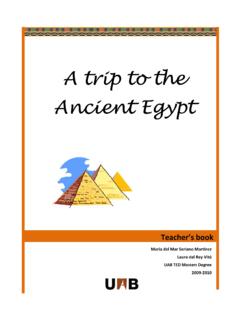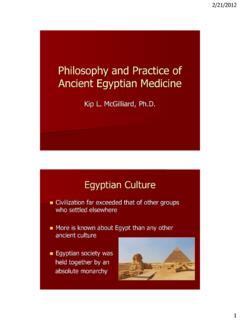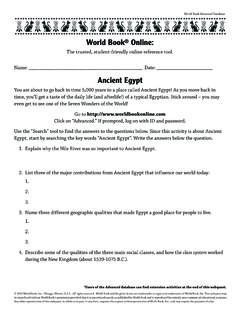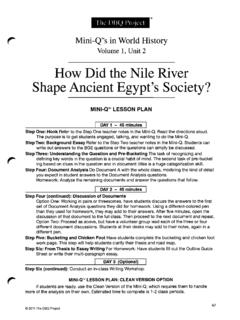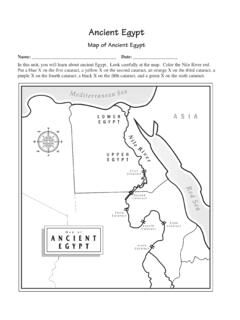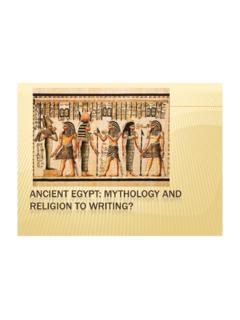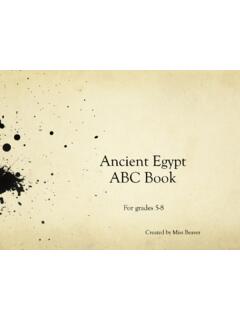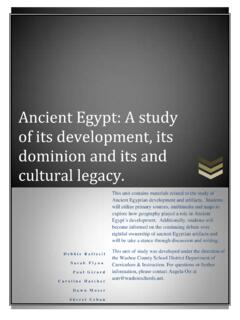Transcription of STUDIES IN ANCIENT EGYPT, - Harvard University
1 STUDIES IN ANCIENT egypt , THE AEGEAN, AND THE SUDAN Essays in honor of Dows Dunham on the occasion of his 90th birthday, June 1, 1980 Edited by William Kelly Simpson and Whitney M. Davis Department of Egyptian and ANCIENT Near Eastern Art Museum of Fine Arts, Boston 1981 An Anubis Figure in the Boston Museum of Fine Arts LYNN HOLDEN In 1908 the Harvard University - Museum of Fine Arts expedition at Giza found two fragments of a jackal statuette in the debris on the floor of Room (III) 2 of the Valley Temple of King Menkaure of Dynasty IV.
2 The jackal figure, MFA , has been in the collection of the Museum of Fine Arts for seventy-seven years and on displav for no small part ofthat time (fig. 1). Even so, it is virtually unknown to This statuette is fashioned in a hard greenish basalt and presents the ani mal in the pose customarv for the god Anubis. The quality of workmanship is the very finest. However, pecking marks visible on the inside of the rear legs and traces of fine abrasion around the ears and knees, indicate the piece is not completely fin ished.
3 The extraordinan' realism and subdety of modelling of the musculature of the rear legs and in the treatment of the eyes combine to emphasize that this stat uette was, without a doubt, one of the most masterful creations of the royal atelier. The head and neck fragment is cm. in length and cm. in width, with the rear section some cm. in length and cm. in width. Originally the dimen sions of the complete figure would have been approximately 56 cm. long by 30 cm.
4 High (fig. 2). The fragment of the head and neck has the snout and ears broken away and the rounded and worn edges of the breaks indicate that the piece was reused as a rubbing or grinding stone. 1. No. 45, Reisner,Mycerinus, p. 114, pi. 64a. Fig. 2. Reconstruction of MFA Drawn by L. Holden. 99 Fig. 1. Jackal figure, MFA Courtesty Museum of Fine Arts, Boston. Perhaps the most remarkable feature of this statuette is the eyes (fig. 3), which are thoroughly human in appearance.
5 The shape and proportions of the eyes are very similar to the eyes on the figures of the Menkaure triads. The lower part of the eyeball is undercut, angling upward to a rather prominent fid. The canine character is achieved by the upper eyebrows which curve back over the receding forehead. The snout of the jackal is completely broken away, but a trace of the right corner of the mouth shows that the lips were modelled in raised relief. The damaged right ear shows that the ears were not solid forms, but were hollowed out in a realistic manner.
6 The general shape of the head is delineated by prominent ridges which run from the corner of the eye to the forward base of the ear and thence down the side of the neck. There is also a shallow depression down the center of the forehead to the brow. On the back of the neck and ears are very small incrustations of a reddish-brown colour, which are neither pigment nor plaster. The hindquarters of the jackal are complete to the front of the rear paws, the abdomen being broken just above that point.
7 The tail of the animal ends abruptly at the lower edge of the base. This part of the statuette does not appear to have received the same abuse inflicted on the head and neck, however, the area just above the tail shows signs of having been used as some type of anvil. The broken section of the abdomen displays very flat upper and lower surfaces with sloping sides creating a trapezoidal effect. The transition from the lower back to the thighs is very fluid with the musculature of the thighs represented by two slight ridges run ning from the base of the tail to the knee.
8 The knees are quite broad and well rounded, more human in form than canine. The lower legs down to the heel are also well modelled, showing tension in the calf muscle and an indentation at the heel. The feet and paws are simple and cylindrical with four toes carved. The claws are not indicated. The base is four centimeters thick and twelve centimeters wide, the shape is rectangular, curving in at the back to conform to the shape of the ani mal. Rough pecking is visible on the sides of the base and on the bottom is a small circular drilled indentation.
9 The Museum of Fine Arts Anubis figure is probably the earliest three-dimensional representation of a jackal and the only sizable statue of this animal to survive from the Old Kingdom. From the Archaic Period many small animal statues survive, such as the lions in the Ashmolean, Turin and Berlin Museums, the baboon in Berlin, the hippopotamus in Athens and the lion in the Metropolitan Museum of Art, to mention only the most However, comparison with these pieces is surprisingly unprofitable.
10 The only animal figures from the Old Kingdom which are comparable, in terms of style and quality of workmanship, are the basalt lion-head waterspouts from the pyramid temple of King Neuserre at Abusir, which were fashioned about fifty years after the Anubis It is pos sible in these lions to see a similar treatment of the facial features, especially the eyes, brows and cheek bones. The lion heads, however, are executed in a more nat uralistic manner. It is only in representations of jackals that human eyes with cos metic stripes are regularly used.
